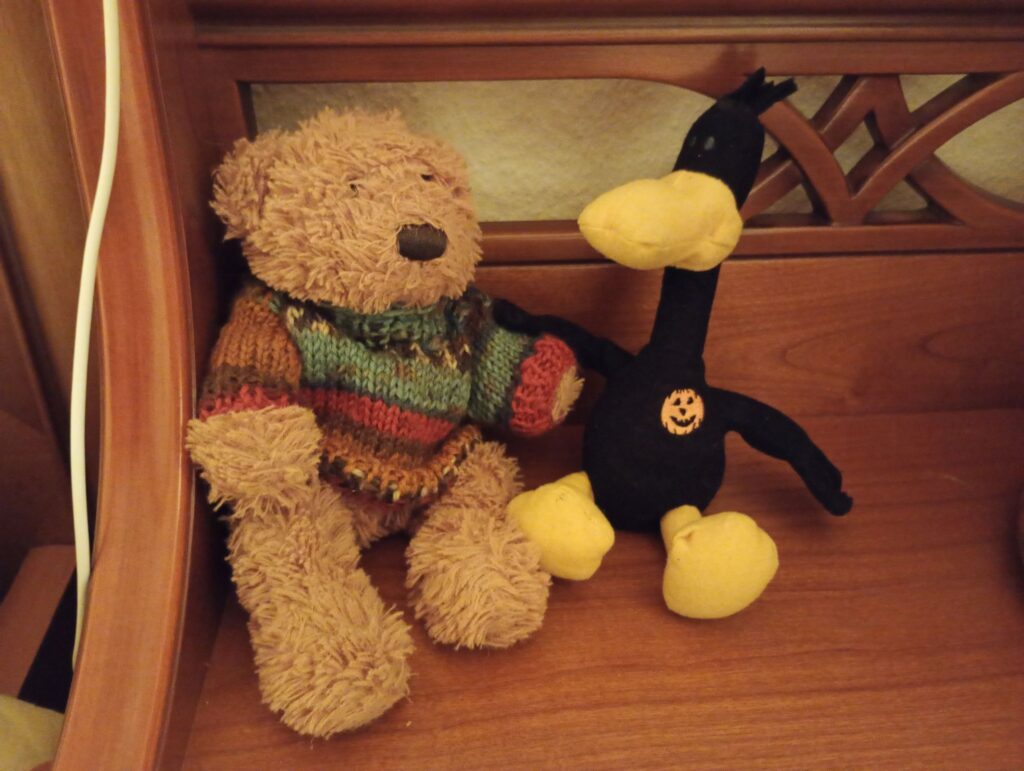
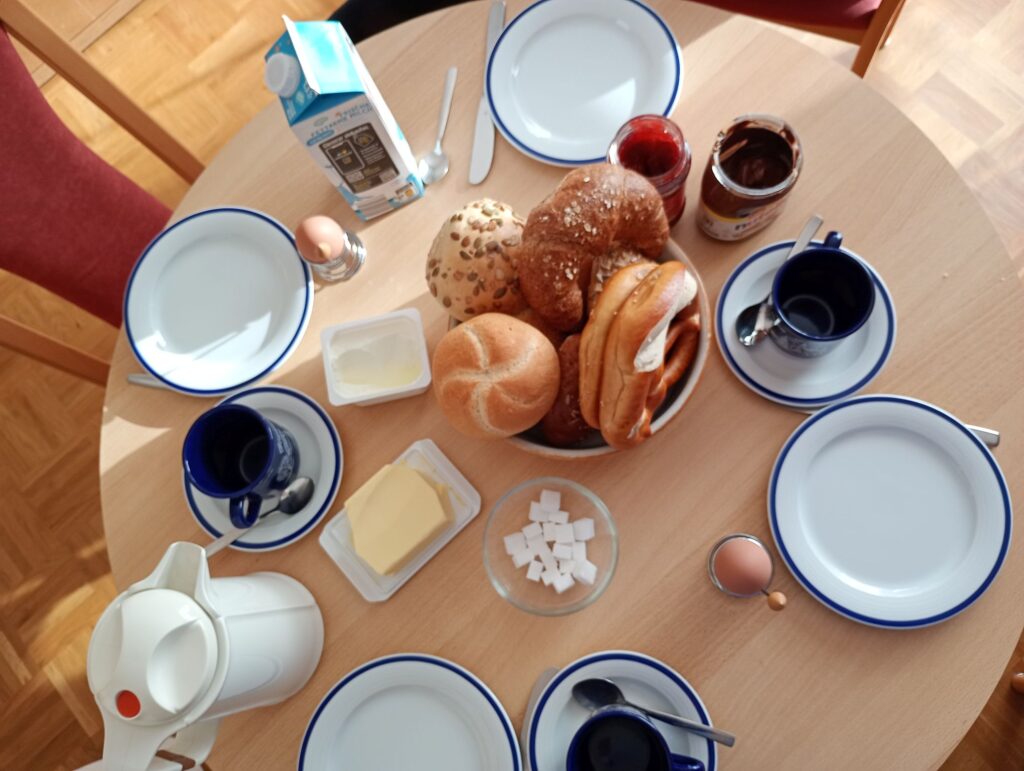
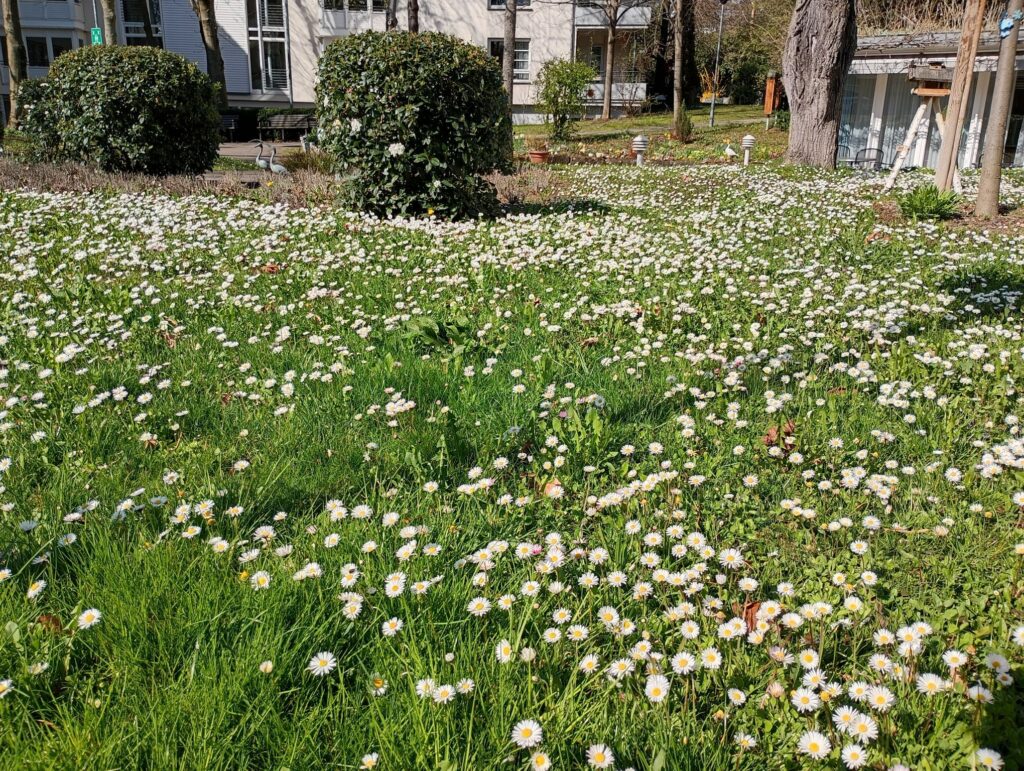
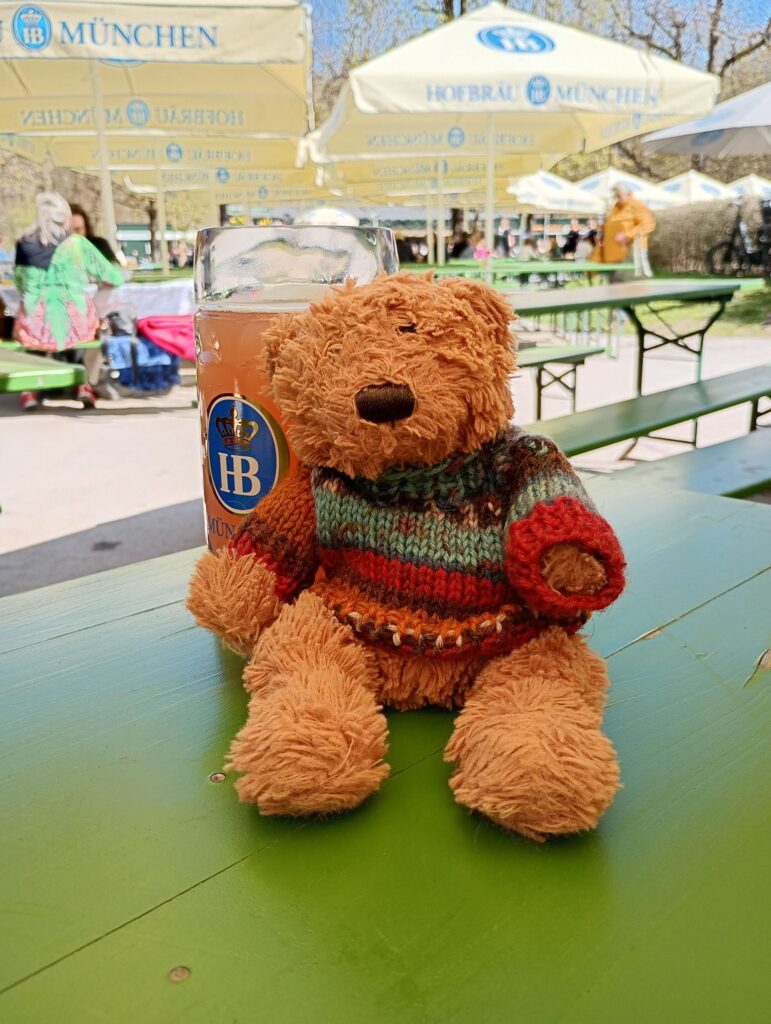
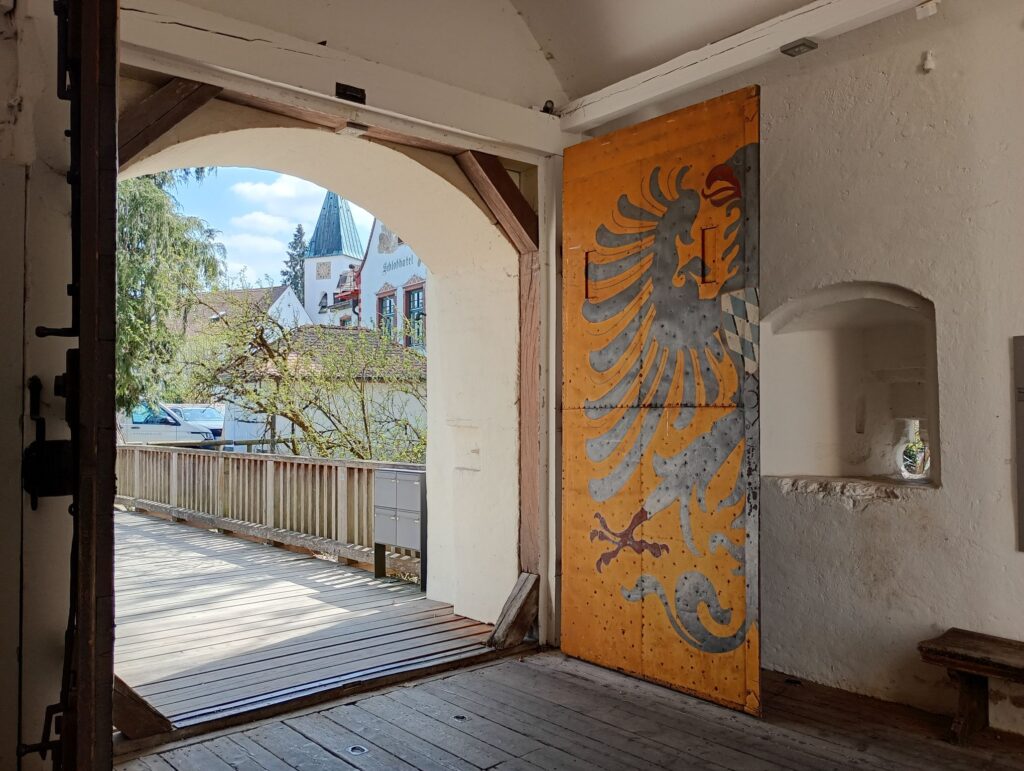

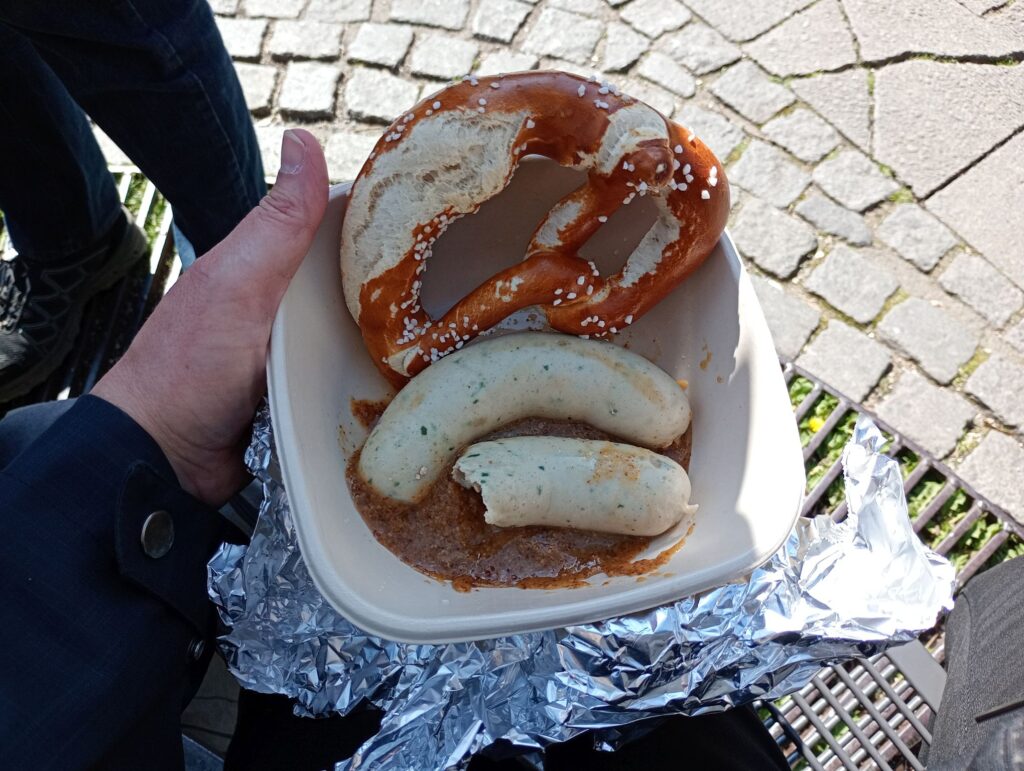
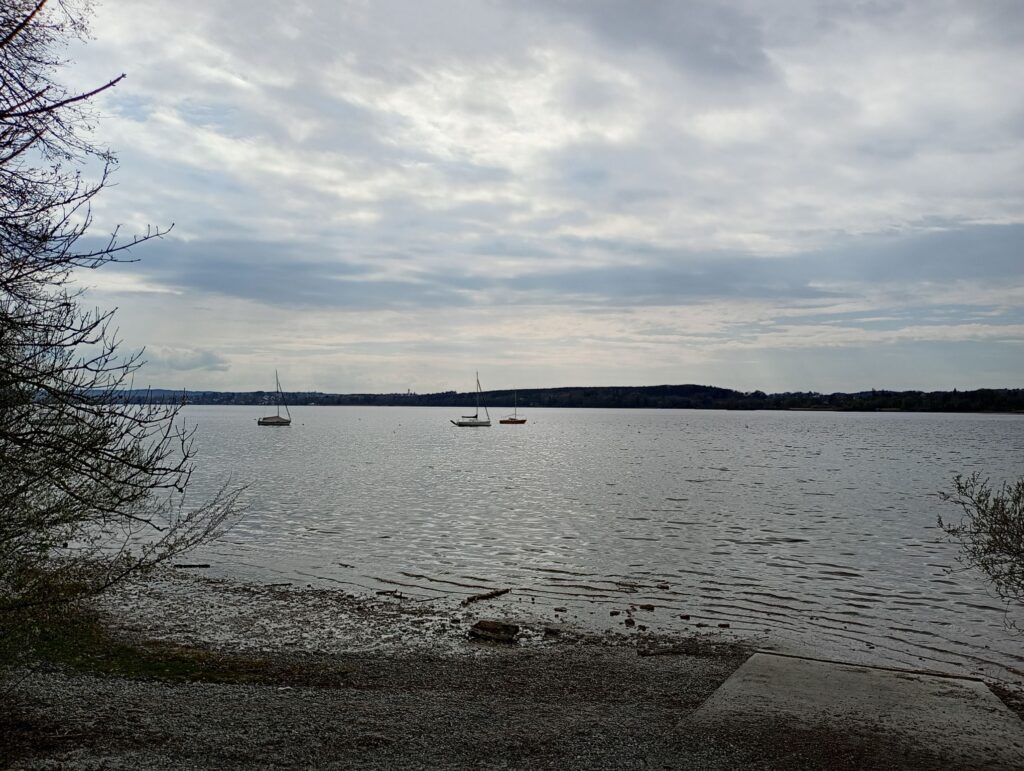
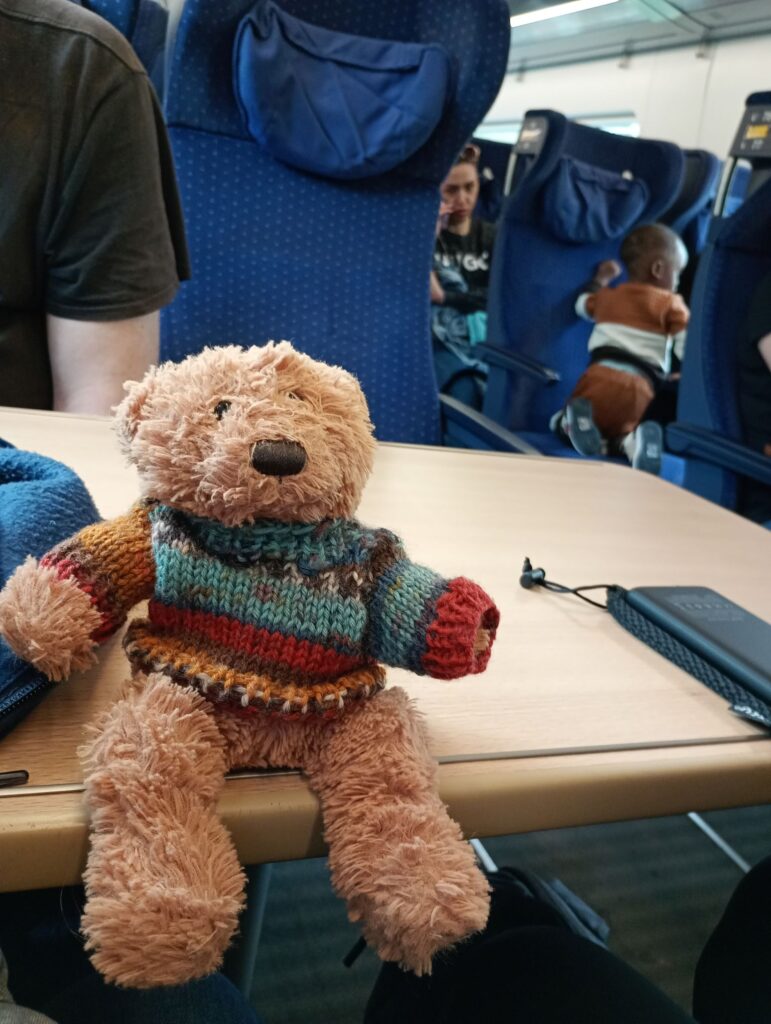

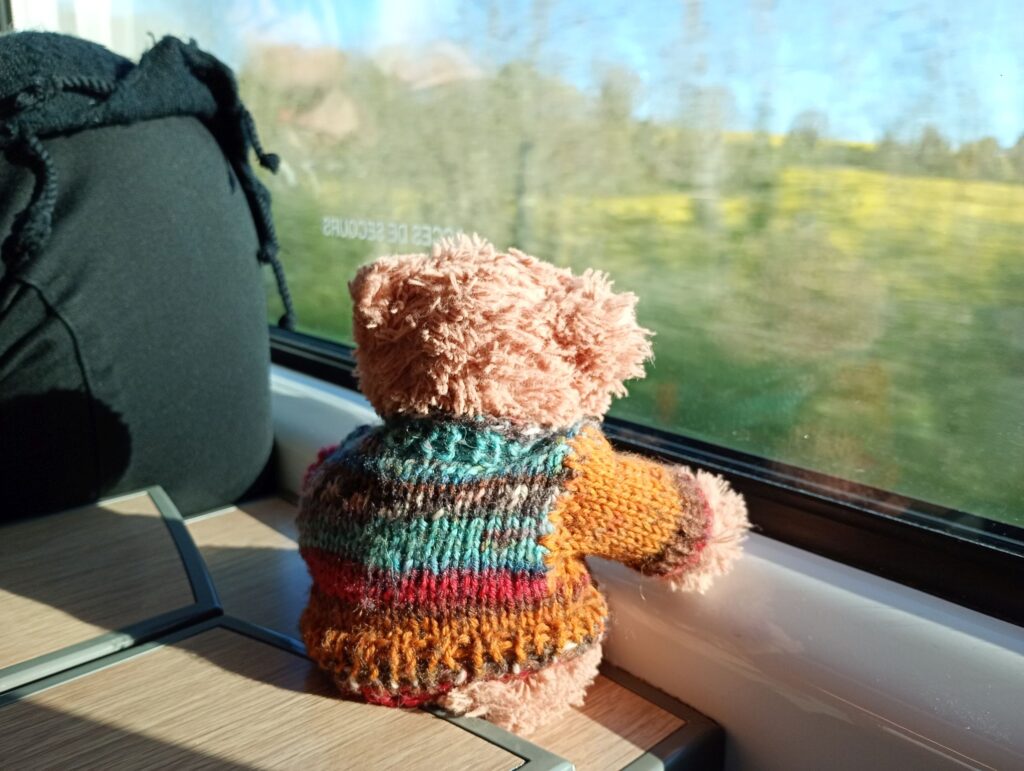
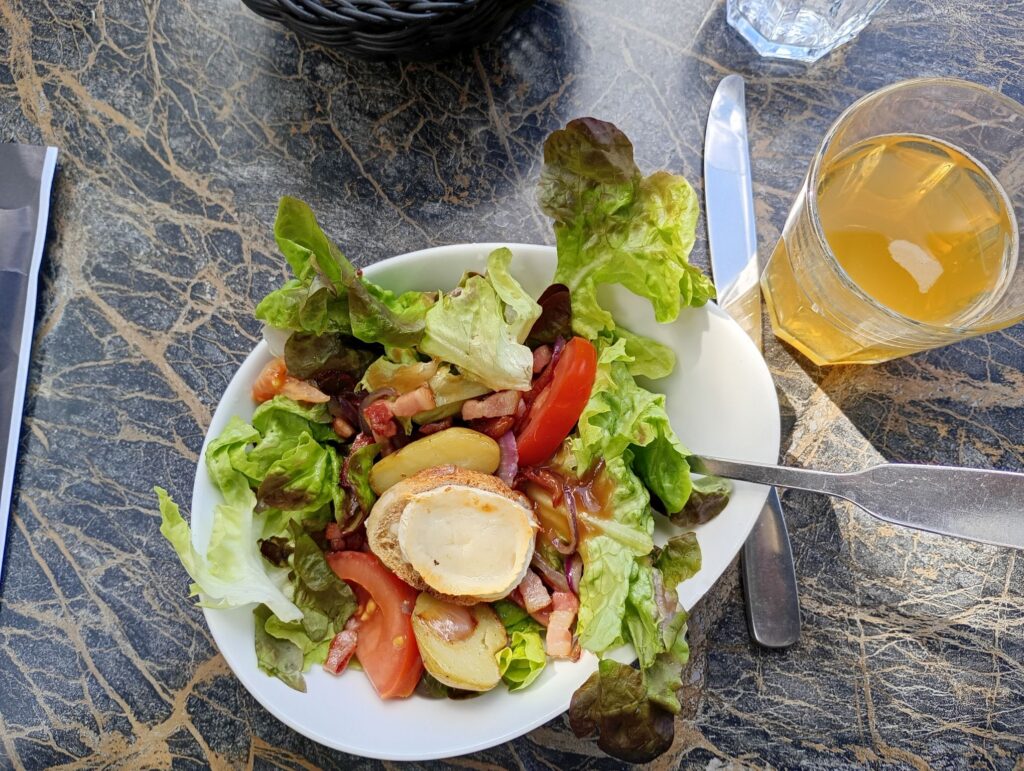
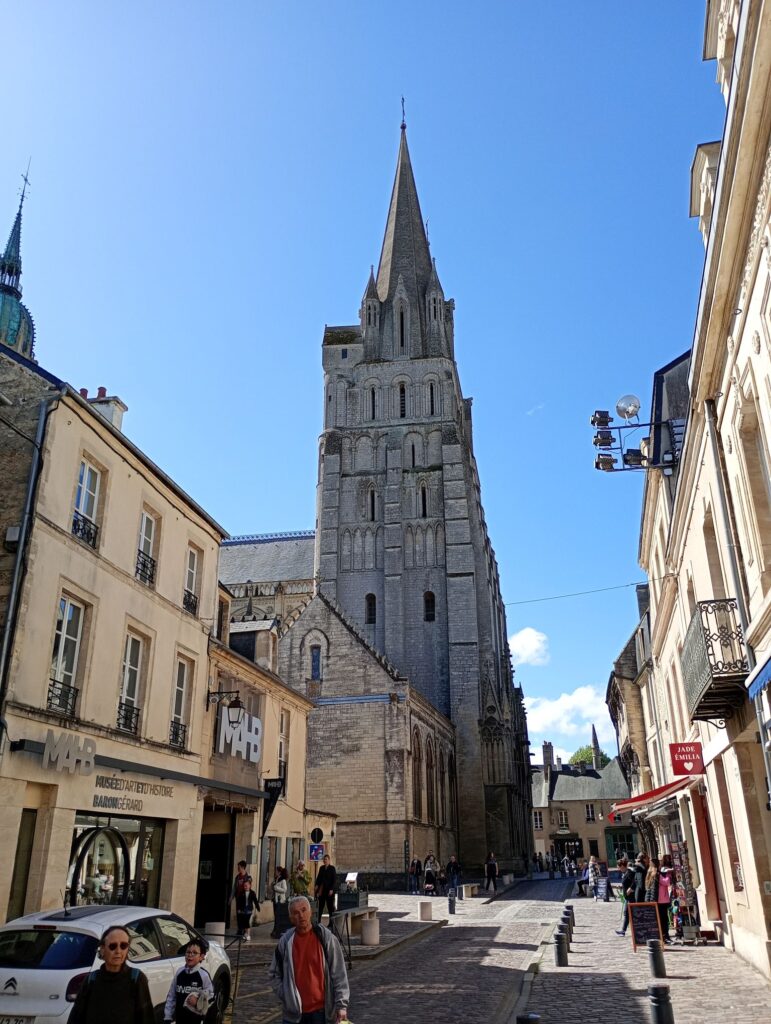
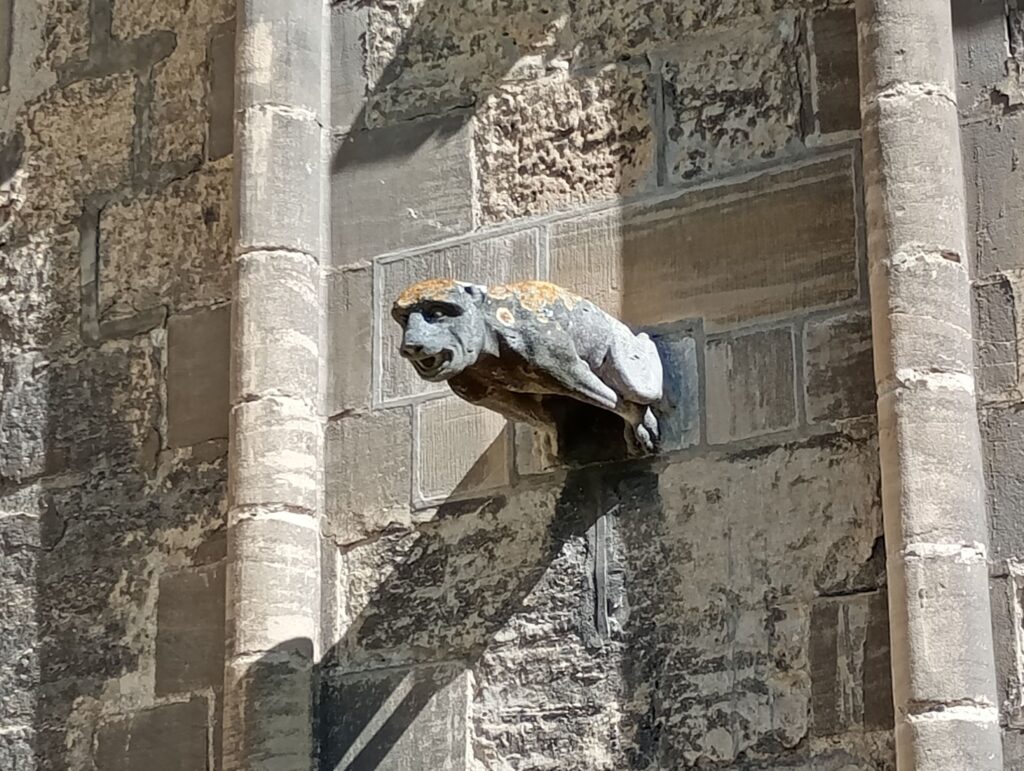
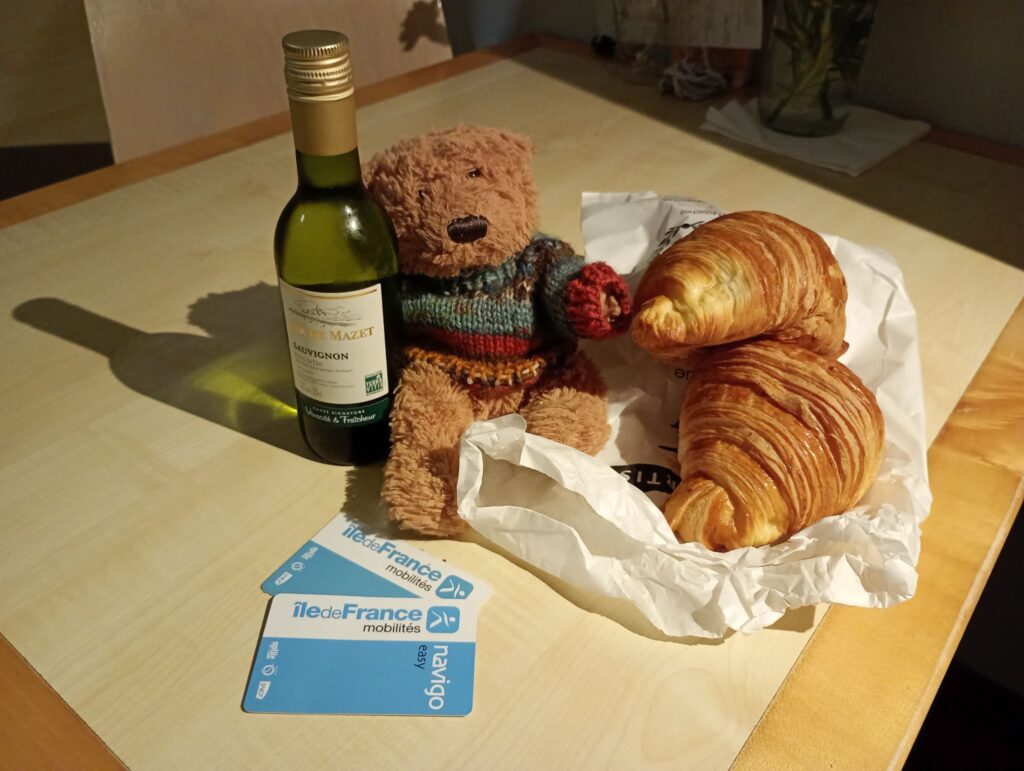
life, the universe, and a few-odd other things




















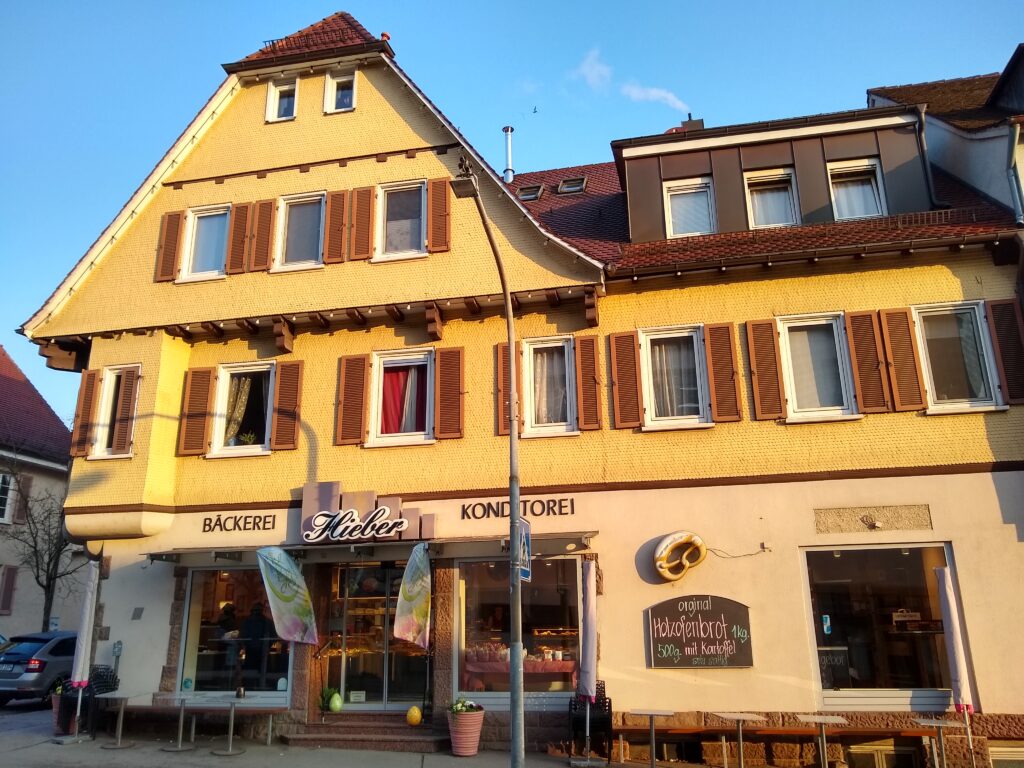
7:45 on an almost-spring morning in a small town in Southern Germany. It’s still chilly enough that I need my fingerless gloves, but the sun is rising in a clear sky, setting the golden stucco of the old bakery at the street corner aglow with the promise of a beautiful day. The upper two stories of the old building look hardly different from how they’ve been for the last century or so, the window shutters beneath the half-hipped red tile roof folded back against the wall to show net-curtain-shrouded windows behind which the inhabitants are starting their day.
But the ground-floor shop windows are as modern as they come. I step through the automatic sliding glass doors into the warm scent of the fresh-baked breads and rolls and pastries that are piled on the shelves against the back wall and displayed behind the glass counter that runs the whole length of the shop.
On the far left, at a small café table a couple of men in business suits down a quick cup of coffee and a roll on their way to catch the train for work. The baker emerges from the back room with an enormous tray piled with fresh pretzels, which he unceremoniously dumps on the counter. Good! Those are just what I’m after. This is Swabia, the original birthplace of the pretzel, and nowhere else are they as good as here. A few salt kernels – not too many – speckle the deep, glossy, mahagony brown of the fat part with the deep slash exposing its creamy interior; the two little twisted arms are thin and crispy. Legend has it they are modelled on the first pretzel baker’s wife’s crossed arms as she watched him bake.
When I turn back to the counter to place my order, I find that two small girls are in line ahead of me, buying a sausage roll, a bread roll, and a couple of pastries for their breaktime snack at school – they’re probably in Grade 1 or 2, no more. “That’ll be €3.40,” the sales lady says as she hands over the paper bag with their goodies, and one of the girls stretches as high as she can to lay her coins on the little wooden tray that sits on top of the glass counter for the purpose. She can barely reach, but she pushes the coins across, grabs her bag, and with a cheerful “Tschüss!” she and her friend skip away. They should still make it in time for school to start at 8:00.
It’s my turn. I can’t be bothered to make a lot of decisions today, choosing from the dozen or more varieties of fresh, crispy bread rolls – white, brown, rye, plain, seeded, sunflower and pumpkin, long or plump or round – so I just ask for three of my favourites, Dinkelbrötchen or spelt rolls: a crispy crust covered in oat flakes, a tender interior with soft chewy spelt kernels throughout. Perfect for a spread of Quark, soft white cheese, topped with strawberry jam. And I ask for two Brezeln, of course.
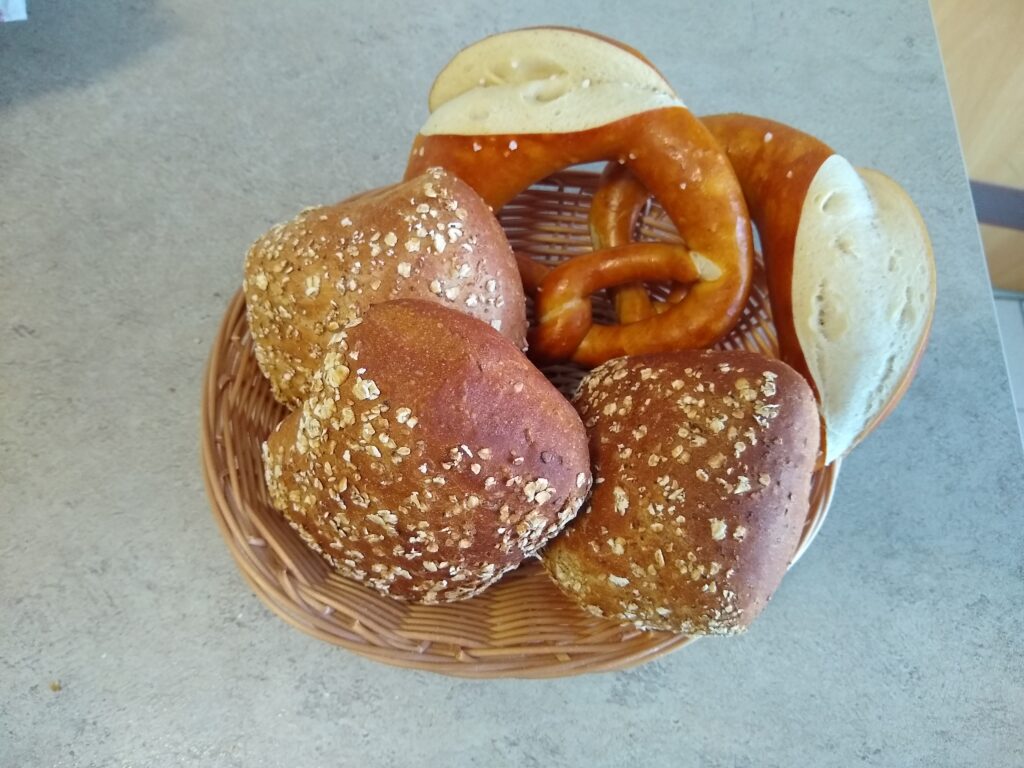
Their warmth is seeping through the paper bag as I step back out into the street. I’m tempted to hug it to myself to warm my hands, but in true European fashion I tuck it into my backpack to carry it the two blocks to where I’m going. The golden hands of the clock tower show five minutes to eight as the drugstore around the corner and the supermarket down the street are getting ready to open their doors to customers. A new day is beginning in this small town.
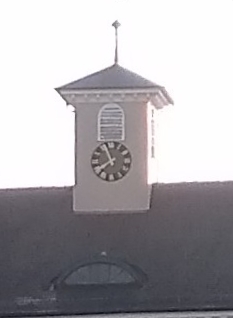
The bakery has been operating in that building for more than four generations. For over a hundred years, children have been stretching to put their coins on the counter to buy a bread roll for recess, then run off to get to school before the bell rings at 8:00; working people bought their coffee and pastry and headed for the train; and folks like myself today with a little time to spare bought fresh, still-warm-from-oven rolls and pretzels to take home for a leisurely breakfast of coffee and bread and cheese and jam. The baker has been up since 3:00am to make it all happen, as did his father and grandfather and great-grandfather before him, and perhaps his daughter and granddaughter will do after him. For all the automatic sliding doors and gleaming plate glass display windows, there is a thread of continuity that runs through the fabric of existence here.
I find my soul being nourished by the warmth that gently seeps out of my bag of Brötchen und Brezeln, and I revel in that sense of being tied into a web of culture that has been in place for generations and will continue for generations to come. It’s unlikely that any children and grandchildren of mine will buy breads and cakes in this place where my grandparents and great-grandparents got theirs, but someone’s children will. The thought is as warm as the rolls and pretzels in my bag.
Life, the Universe, and a visit to the German bakery. I’m bringing breakfast today.
Where has March gone? Wasn’t it just February, like, last week? Apparently not. Well, at least I didn’t just randomly lose the month as I’m wont to do. I know exactly what happened to it: I spent it on a short-notice trip to Europe for family reasons. As I might have mentioned before, having your family a third of the way around the globe is a pain in the you-know-what, but visits have the added perk that you get to do some touristy stuff on the side. “Love where you find yourself,” and all that, you know?
My route home took me via France, where the Paris-dwelling Offspring and I indulged ourselves by pretending to be cultured. It was great fun. So as a small sampling of our jollifications, I present to you …
[The curtain slowly rises, the orchestra strikes up.]

The Paris Opera, as I’m sure you know (haha—I certainly didn’t before this), has two buildings, the Palais Garnier and the Opéra Bastille. The latter is a modern building, from 1989, all clean, straight (or swooping) lines and cement—now that I look at the photos, from across the auditorium the balconies look rather like the overhead luggage compartments in airplanes while everyone is stowing their carry-ons. The Opera Bastille houses the actual opera, as in, productions where people wander about on stage singing loudly and impressively while waving their arms.

So the Offspring purchased us some rather pricey tickets, and off we went to the show. It was weird. I mean, really weird. Hamlet, the opera, is an adaptation of an adaptation of an adaptation: Someone named Ducis adapted the Shakespeare play into French; Dumas, père, made Ducis’ version better by putting back some of the Shakespeare; Carré and Barbier wrote a libretto of Dumas’ take; then in 1868 Ambroise Thomas wrote music to go with it. Fairly early on in all this adapting they messed with the ending, kind of like Disney did with “The Little Mermaid”: this Hamlet doesn’t die, but gets to live out a natural lifespan, profoundly depressed, as king of Denmark. (Apparently the British audiences at Covent Garden got so ticked off at this sacrilege, the opera was adapted yet again for them and the death scene at the end was restored. To die or not to die, that is the question…)
And of course, a production of an opera is a whole other step again. So here we have a 16th century play, turned into a 19th century opera, put on in a 21st-century style. I think Surrealism is the term that comes closest for this particular performance. A lot of it left us scratching our heads, and not because it’s in French, as they actually had subtitles so you could follow. I kid you not—there was a screen at the top of the stage (so I guess it was really surtitles?) that had the French words with the English translation underneath. So we knew what they were saying (and we know the Shakespeare version fairly well, anyway), but it’s the setting and the actions that went with it that were puzzling. For example, there was one character, a member of the chorus, who periodically came out in a mime face and stood at the side of the stage, knitting. Huh? The best we could come up with was that he might have been meant as a representation of one of the Fates.
However, as I said, we greatly enjoyed ourselves. The music is beautiful, and the singing—wow. And watching that strange surrealist setting and trying to figure out what they were trying to do or say with it made us feel rather clever.
We had so much fun at the Opera that we decided to try it again the next day.


The Palais Garnier, or Opera Garnier, is the original Paris Opera building, and today is mostly used for ballet performances by the Paris Opera Ballet company.
If you go to the ticket office on the day of a performance, subject to availability you can get cheap “partially obstructed view” seats. So for €12 each, we got to see a ballet! Truth be told, it was weird and surrealistic, too. But again, we had fun. And the best part of that whole experience was not the performance per se, but the building.

The Palais Garnier is the quintessential opera house—in fact, it’s the setting for Phantom of the Opera. Built in the 1860s under Napoleon III, it hits every stereotype you can think of. Gilding, marble, statues, red plush (the red plush! Everywhere!), swooping curtains (of red plush, or painted to resemble red plush), tiers and tiers of boxes (lined with red plush), rows and rows of seats (upholstered in red plush), sparkling chandeliers dripping with crystals (those aren’t red plush), grand sweeping staircases, saloons… It’s mind-boggling.




I had to keep myself from squealing out loud when we got to our box—actually, I might have squealed just the teensiest bit. You step from the sweeping curved hallway through one of the many little doors that are side by side in a round wall, and you’re in a tiny, dimly lit red plush foyer—maybe five feet wide, and eight feet deep. There is a bench on one side to rest your weary slipper-shod feet, coat hooks on the opposite wall for your opera cloak, a little shelf to put down your opera bag while you use the red-plush-framed mirror above it to straighten your elegant opera coiffure. Straight ahead is a looped back red plush curtain, through which you can see six red-plush-and-gilt chairs, arranged in three rows. And beyond them, past the red plush railing, the great red-plush-and-gilt cavern of the auditorium, with its enormous chandelier suspended above from the centre of a rainbow riot of Marc Chagall paintings. The Chagall ceiling is the only piece that is not in keeping with the 19th-century opulence, being of an entirely different style of overwhelming colour, but it’s Chagall—it’s glorious.


The tickets we had were for the two back-row chairs of our box; about a quarter of the stage would have been obscured by the sides of the box, but we could have seen it standing up and leaning over a bit. We got there early enough that nobody else was there yet, which is why I was able to sit in one of the front seats for a few minutes, staring at the Chagall, and just revel in all the red-plushness around me. Eventually I moved back, though, because the box is so narrow that there is just barely enough room between the chairs to get past, and I didn’t want the awkwardness of having to do a seat-swapping tango with our fellow box occupants. (Come to think of it, I wonder how, in the days when the theatre was new, Victorian ladies in their crinolines ever got in and out of those boxes…) But we were lucky: the couple that arrived shortly before the beginning of the performance took the front two seats, and then nobody else came. So we moved up to the middle seats, and with just a bit of neck-craning were able to see most of the stage.

I don’t have too much to say about the performance—as I mentioned, it too was rather strange and very, umm, modern. However, the skill of the dancers was astounding and a delight to watch, and I for one found that surrealistic weirdness is easier to enjoy when it comes through a medium that is already mostly abstract, such as dance and instrumental music. I didn’t quite follow the plot of the story they were telling, but that didn’t bother me much, as the experience of just being in the Palais Garnier is what made it all worthwhile.
And then the performance ended, and we streamed along with the rest of the audience out through the gilt-and-marble foyer into the rainy Paris street and down into the Metro system. And not just the audience, either: just before our train doors closed a well-dressed woman jumped into the car, a violin case strapped to her back—obviously one of the members of the orchestra. Just your ordinary Parisian working woman on her way home from her work shift.
Somehow that seemed to put the final touch to the experience. It was all so “Europe”: gilt and red plush, surrealism and a classical orchestra, high culture and utterly democratic public transit. A tale of two operas, a tale of two worlds that are, really, just one.
Life, the Universe, and a Tale of Two Operas. It was the best of times, it was the… No, not that. It really was wonderful.


At long last, Steve and I are packing our bags again for a jaunt to the Old Country on a family visit! And you’re seeing that right: this time, we’re going to Germany via Paris – which is also a family visit, as one of the Offspring is going to uni there at the moment. I’ve never been there (neither has Steve, for that matter), so we’re bringing a guide book to tell us where the best spots are. Paris will be just a three-day stint, so we’ll have to make the most of it.
I thought that maybe I’d give you a little glimpse into the packing process, the way I’ve done it for the last, oh, four or five years or so, and pass on a few tips I’ve collected on the way.
As you can tell by the guide book, I’m a big fan of Rick Steves, the travel writer/presenter. I have no affiliation with him or his organization whatsoever, I just like his travel philosophy, his TV shows, and his swag. (Although, Rick, if you’re reading this and want to hire me or give me a discount on one of your guided tours, my contact info is at the top…)
A few years ago I stopped in at the Rick Steves flagship store outside of Seattle and treated myself to one of his carry-on backpacks. They’re specially designed to fit the maximum dimensions of airline carry-on luggage while still being perfectly portable – genius. The other genius design is the Packing Cubes: zippered stretchy mesh cubes to hold your stuff. Of course, they’re sized to perfectly fit the inside of the backpack.
Having packing cubes in my luggage is like having portable dresser drawers: one for my T-shirts, one for my PJ’s and night things, the big one for pants and sweaters, and another medium-sized one for toiletries and bits and bobs. I always know exactly where to lay hands on what piece of clothing, which, in a soft bag, isn’t necessarily a given. And here’s a trick: always roll your clothes, don’t fold them. A nice tight sausage of a T-shirt packs more neatly and takes up less room than a flat-folded one. (I got that tip from Lee Strauss, my friend/editing client/fellow writer, who is a veteran traveller.)
The other packing trick that’s been really helpful is to vacuum-pack small items of clothing such as socks and underwear. I put them (rolled up tightly, of course) into a big ziplock freezer bag, squeeze all the air out, and zip it shut. That way it takes about half the amount of space it would take un-compressed.







So, T-shirts, a sweater or two, spare pants, maybe a piece or two of something dressy, underwear and socks, toiletries, a second pair of shoes – what else? A notebook and pen and my trusty Kobo ereader (do you think the 600 books I’ve got on there will last me the three weeks I’m gone?). This time I’m bringing my little netbook, so I can still get on the internet in case my phone packs it in or gets stolen (the latter of which is apparently a distinct possibility in Paris). A couple of collapsible extra bags – a small, lightweight backpack for a daypack, and a foldable duffle bag to haul back all the balls of self-patterning sock yarn I intend to stock up on in Germany (yes, I’ve got checked luggage booked for the return trip).
The backpack is full – very full. But everything fits. All that’s left to do is stick in my small pillow (without which I can’t sleep), put Steve on top, and tighten the straps across (he gets strapped in solidly – a bear’s gotta have his seatbelt on).
And now I’d better get to bed, as I won’t be getting a whole lot of sleep for the next couple of days.
This is Life, the Universe, and At Long Last Another Trip. I’ll try to keep you posted on our adventures!





